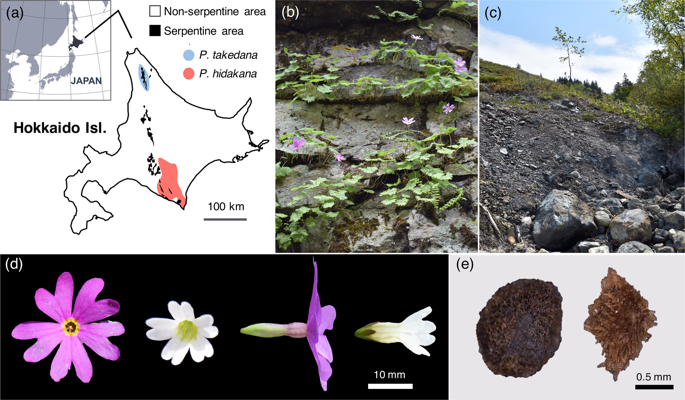Our official English website, www.x-mol.net, welcomes your
feedback! (Note: you will need to create a separate account there.)
Speciation and subsequent secondary contact in two edaphic endemic primroses driven by Pleistocene climatic oscillation
Heredity ( IF 3.1 ) Pub Date : 2019-06-28 , DOI: 10.1038/s41437-019-0245-8 Masaya Yamamoto 1 , Daiki Takahashi 2 , Kiyoshi Horita 3 , Hiroaki Setoguchi 2
Heredity ( IF 3.1 ) Pub Date : 2019-06-28 , DOI: 10.1038/s41437-019-0245-8 Masaya Yamamoto 1 , Daiki Takahashi 2 , Kiyoshi Horita 3 , Hiroaki Setoguchi 2
Affiliation

|
Climatic perturbation during the Pleistocene era has played a major role in plant evolutionary history by altering species distribution range. However, the relative roles of climatic and geographic factors in the distribution dynamics remain poorly understood; in particular, the edaphic endemics. In this paper, we examine the evolutionary history of two ultramafic primroses, Primula hidakana and Primula takedana . These species are ecologically and morphologically distinct with disjunct distributions on Hokkaido Island, Japan. Primula hidakana is found on various rocks in southern Hokkaido and P . takedana in serpentine areas in northern Hokkaido. We performed population genetics analyses on nuclear and chloroplast data sets and tested alternative phylogenetic models of divergence using approximate Bayesian computation (ABC) analyses. Nuclear microsatellite loci clearly distinguished the two sister taxa. In contrast, chloroplast sequence variations were shared between P. takedana and P. hidakana . ABC analyses based on nuclear data supported a secondary contact scenario involving asymmetrical gene flow from P . hidakana to P . takedana . Paleodistribution modeling also supported the divergence model, and predicted their latitudinal range shifts leading to past secondary contact. Our findings highlight the importance of the distribution dynamics during the Pleistocene climatic oscillations in the evolution of serpentine plants, and demonstrate that tight species cohesion between serpentine and nonserpentine sister taxa has been maintained despite past interspecific gene flow across soil boundaries.
中文翻译:

更新世气候振荡驱动的两种土壤地方性报春花的物种形成和随后的二次接触
更新世时期的气候扰动通过改变物种分布范围在植物进化史上发挥了重要作用。然而,气候和地理因素在分布动态中的相对作用仍然知之甚少;特别是土壤地方病。在本文中,我们研究了两种超镁铁质报春花,Primula hidakana 和 Primula takedana 的进化史。这些物种在生态和形态上是不同的,在日本北海道岛上分布不连续。Primula hidakana 被发现在北海道南部和 P 的各种岩石上。北海道北部蛇纹石地区的竹刀。我们对核和叶绿体数据集进行了群体遗传学分析,并使用近似贝叶斯计算 (ABC) 分析测试了分歧的替代系统发育模型。核微卫星位点清楚地区分了两个姐妹类群。相比之下,叶绿体序列变异在 P. takedana 和 P. hidakana 之间共享。基于核数据的 ABC 分析支持涉及来自 P 的不对称基因流的二次接触情景。hidakana 到 P 。武当 古分布模型也支持散度模型,并预测它们的纬度范围变化导致过去的二次接触。我们的研究结果强调了蛇纹石植物进化过程中更新世气候振荡期间分布动态的重要性,并证明尽管过去种间基因跨土壤边界流动,但蛇纹石和非蛇纹石姊妹类群之间的紧密物种凝聚力仍然保持。叶绿体序列变异在 P. takedana 和 P. hidakana 之间共享。基于核数据的 ABC 分析支持涉及来自 P 的不对称基因流的二次接触情景。hidakana 到 P 。武当 古分布模型也支持散度模型,并预测它们的纬度范围变化导致过去的二次接触。我们的研究结果强调了蛇纹石植物进化过程中更新世气候振荡期间分布动态的重要性,并证明尽管过去种间基因跨土壤边界流动,但蛇纹石和非蛇纹石姊妹类群之间的紧密物种凝聚力仍然保持。叶绿体序列变异在 P. takedana 和 P. hidakana 之间共享。基于核数据的 ABC 分析支持涉及来自 P 的不对称基因流的二次接触情景。hidakana 到 P 。武当 古分布模型也支持散度模型,并预测它们的纬度范围变化导致过去的二次接触。我们的研究结果强调了蛇纹石植物进化过程中更新世气候振荡期间分布动态的重要性,并证明尽管过去种间基因跨土壤边界流动,但蛇纹石和非蛇纹石姊妹类群之间的紧密物种凝聚力仍然保持。基于核数据的 ABC 分析支持涉及来自 P 的不对称基因流的二次接触情景。hidakana 到 P 。武当 古分布模型也支持散度模型,并预测它们的纬度范围变化导致过去的二次接触。我们的研究结果强调了蛇纹石植物进化过程中更新世气候振荡期间分布动态的重要性,并证明尽管过去种间基因跨土壤边界流动,但蛇纹石和非蛇纹石姊妹类群之间的紧密物种凝聚力仍然保持。基于核数据的 ABC 分析支持涉及来自 P 的不对称基因流的二次接触情景。hidakana 到 P 。武当 古分布模型也支持散度模型,并预测它们的纬度范围变化导致过去的二次接触。我们的研究结果强调了蛇纹石植物进化过程中更新世气候振荡期间分布动态的重要性,并证明尽管过去种间基因跨土壤边界流动,但蛇纹石和非蛇纹石姊妹类群之间的紧密物种凝聚力仍然保持。
更新日期:2019-06-28
中文翻译:

更新世气候振荡驱动的两种土壤地方性报春花的物种形成和随后的二次接触
更新世时期的气候扰动通过改变物种分布范围在植物进化史上发挥了重要作用。然而,气候和地理因素在分布动态中的相对作用仍然知之甚少;特别是土壤地方病。在本文中,我们研究了两种超镁铁质报春花,Primula hidakana 和 Primula takedana 的进化史。这些物种在生态和形态上是不同的,在日本北海道岛上分布不连续。Primula hidakana 被发现在北海道南部和 P 的各种岩石上。北海道北部蛇纹石地区的竹刀。我们对核和叶绿体数据集进行了群体遗传学分析,并使用近似贝叶斯计算 (ABC) 分析测试了分歧的替代系统发育模型。核微卫星位点清楚地区分了两个姐妹类群。相比之下,叶绿体序列变异在 P. takedana 和 P. hidakana 之间共享。基于核数据的 ABC 分析支持涉及来自 P 的不对称基因流的二次接触情景。hidakana 到 P 。武当 古分布模型也支持散度模型,并预测它们的纬度范围变化导致过去的二次接触。我们的研究结果强调了蛇纹石植物进化过程中更新世气候振荡期间分布动态的重要性,并证明尽管过去种间基因跨土壤边界流动,但蛇纹石和非蛇纹石姊妹类群之间的紧密物种凝聚力仍然保持。叶绿体序列变异在 P. takedana 和 P. hidakana 之间共享。基于核数据的 ABC 分析支持涉及来自 P 的不对称基因流的二次接触情景。hidakana 到 P 。武当 古分布模型也支持散度模型,并预测它们的纬度范围变化导致过去的二次接触。我们的研究结果强调了蛇纹石植物进化过程中更新世气候振荡期间分布动态的重要性,并证明尽管过去种间基因跨土壤边界流动,但蛇纹石和非蛇纹石姊妹类群之间的紧密物种凝聚力仍然保持。叶绿体序列变异在 P. takedana 和 P. hidakana 之间共享。基于核数据的 ABC 分析支持涉及来自 P 的不对称基因流的二次接触情景。hidakana 到 P 。武当 古分布模型也支持散度模型,并预测它们的纬度范围变化导致过去的二次接触。我们的研究结果强调了蛇纹石植物进化过程中更新世气候振荡期间分布动态的重要性,并证明尽管过去种间基因跨土壤边界流动,但蛇纹石和非蛇纹石姊妹类群之间的紧密物种凝聚力仍然保持。基于核数据的 ABC 分析支持涉及来自 P 的不对称基因流的二次接触情景。hidakana 到 P 。武当 古分布模型也支持散度模型,并预测它们的纬度范围变化导致过去的二次接触。我们的研究结果强调了蛇纹石植物进化过程中更新世气候振荡期间分布动态的重要性,并证明尽管过去种间基因跨土壤边界流动,但蛇纹石和非蛇纹石姊妹类群之间的紧密物种凝聚力仍然保持。基于核数据的 ABC 分析支持涉及来自 P 的不对称基因流的二次接触情景。hidakana 到 P 。武当 古分布模型也支持散度模型,并预测它们的纬度范围变化导致过去的二次接触。我们的研究结果强调了蛇纹石植物进化过程中更新世气候振荡期间分布动态的重要性,并证明尽管过去种间基因跨土壤边界流动,但蛇纹石和非蛇纹石姊妹类群之间的紧密物种凝聚力仍然保持。











































 京公网安备 11010802027423号
京公网安备 11010802027423号